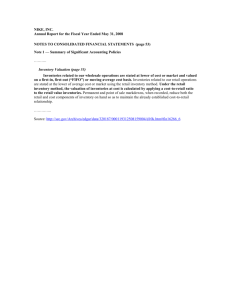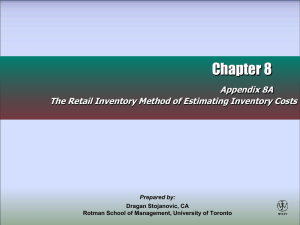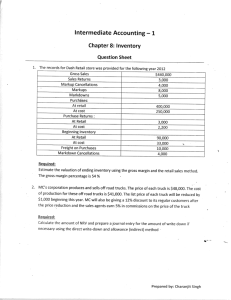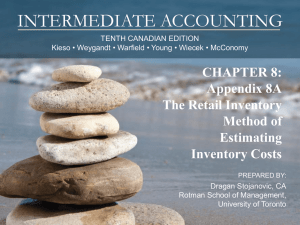RETAIL INVENTORY METHOD APPENDIX D A
advertisement
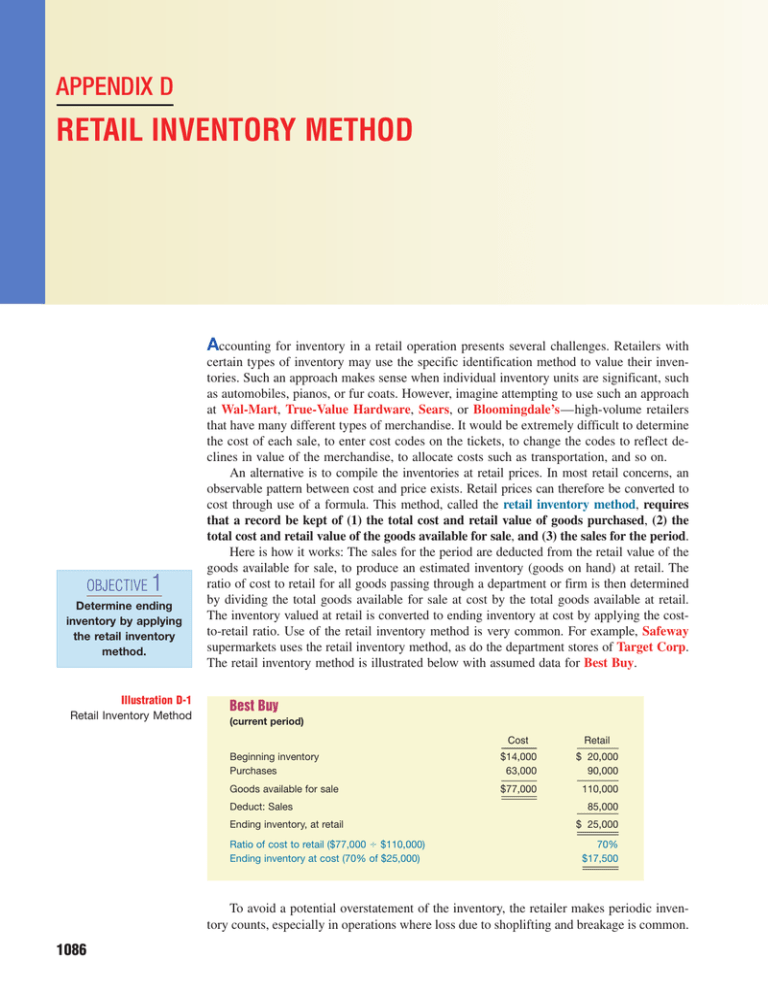
APPENDIX D RETAIL INVENTORY METHOD OBJECTIVE 1 Determine ending inventory by applying the retail inventory method. Illustration D-1 Retail Inventory Method Accounting for inventory in a retail operation presents several challenges. Retailers with certain types of inventory may use the specific identification method to value their inventories. Such an approach makes sense when individual inventory units are significant, such as automobiles, pianos, or fur coats. However, imagine attempting to use such an approach at Wal-Mart, True-Value Hardware, Sears, or Bloomingdale’s—high-volume retailers that have many different types of merchandise. It would be extremely difficult to determine the cost of each sale, to enter cost codes on the tickets, to change the codes to reflect declines in value of the merchandise, to allocate costs such as transportation, and so on. An alternative is to compile the inventories at retail prices. In most retail concerns, an observable pattern between cost and price exists. Retail prices can therefore be converted to cost through use of a formula. This method, called the retail inventory method, requires that a record be kept of (1) the total cost and retail value of goods purchased, (2) the total cost and retail value of the goods available for sale, and (3) the sales for the period. Here is how it works: The sales for the period are deducted from the retail value of the goods available for sale, to produce an estimated inventory (goods on hand) at retail. The ratio of cost to retail for all goods passing through a department or firm is then determined by dividing the total goods available for sale at cost by the total goods available at retail. The inventory valued at retail is converted to ending inventory at cost by applying the costto-retail ratio. Use of the retail inventory method is very common. For example, Safeway supermarkets uses the retail inventory method, as do the department stores of Target Corp. The retail inventory method is illustrated below with assumed data for Best Buy. Best Buy (current period) Cost Retail Beginning inventory Purchases $14,000 63,000 $ 20,000 90,000 Goods available for sale $77,000 110,000 Deduct: Sales Ending inventory, at retail Ratio of cost to retail ($77,000 $110,000) Ending inventory at cost (70% of $25,000) 85,000 $ 25,000 70% $17,500 To avoid a potential overstatement of the inventory, the retailer makes periodic inventory counts, especially in operations where loss due to shoplifting and breakage is common. 1086 Retail Inventory Method with Markups and Markdowns—Conventional Method There are different versions of the retail inventory method—the conventional (lowerof-average-cost-or-market) method, the cost method, the LIFO retail method, and the dollarvalue LIFO retail method. Regardless of which version is used, the retail inventory method is sanctioned by the IRS, various retail associations, and the accounting profession. One of its advantages is that the inventory balance can be approximated without a physical count. The retail inventory method is particularly useful for any type of interim report, because a fairly quick and reliable measure of the inventory value is usually needed. Insurance adjusters often use this approach to estimate losses from fire, flood, or other type of casualty. This method also acts as a control device because any deviations from a physical count at the end of the year have to be explained. In addition, the retail method expedites the physical inventory count at the end of the year. The crew taking the physical inventory need record only the retail price of each item; there is no need to look up each item’s invoice cost, thereby saving time and expense. RETAIL METHOD CONCEPTS The amounts shown in the Retail column of Illustration D-1 represent the original retail prices, assuming no price changes. Sales prices are frequently marked up or down. For retailers, the term markup means an additional markup of the original retail price. (In another context, such as the gross profit discussion in Chapter 9, we often think of markup on the basis of cost.) Markup cancellations are decreases in prices of merchandise that had been marked up above the original retail price. Markdowns below the original sales prices may be necessary because of a decrease in the general level of prices, special sales, soiled or damaged goods, overstocking, and competition. Markdowns are common in retailing these days. Markdown cancellations occur when the markdowns are later offset by increases in the prices of goods that had been marked down—such as after a one-day sale. Neither a markup cancellation nor a markdown cancellation can exceed the original markup or markdown. To illustrate these different concepts, assume that Designer Clothing Store recently purchased 100 dress shirts from Marroway, Inc. The cost for these shirts was $1,500, or $15 a shirt. Designer Clothing established the selling price on these shirts at $30 a shirt. The manager noted that the shirts were selling quickly, so he added a markup of $5 per shirt. This markup made the price too high for customers, and sales lagged. The manager then reduced the price to $32. At this point we would say that Designer Clothing has had a markup of $5 and a markup cancellation of $3. As soon as the major marketing season passed, the manager marked the remaining shirts down to a sales price of $23. At this point, an additional markup cancellation of $2 has taken place, and a $7 markdown has occurred. If the shirts are later written up to $24, a markdown cancellation of $1 would occur. RETAIL INVENTORY METHOD WITH MARKUPS AND MARKDOWNS—CONVENTIONAL METHOD Retailers use markup and markdown concepts in developing the proper inventory valuation at the end of the accounting period. To obtain the appropriate inventory figures, proper treatment must be given to markups, markup cancellations, markdowns, and markdown cancellations. To illustrate the different possibilities, consider the data for In-Fashion Stores Inc., shown in Illustration D-2 (page 1088). In-Fashion’s ending inventory at cost can be calculated under two assumptions, A and B. (The reasons for the two will be explained later.) Assumption A: Computes a cost ratio after markups (and markup cancellations) but before markdowns. Assumption B: Computes a cost ratio after both markups and markdowns (and cancellations). 1087 1088 Appendix D Retail Inventory Method Illustration D-2 Retail Inventory Method with Markups and Markdowns Cost Beginning inventory Purchases (net) Markups Markup cancellations Markdowns Markdown cancellations Sales (net) $ Retail 500 20,000 $ 1,000 35,000 3,000 1,000 2,500 2,000 25,000 In-Fashion Stores Inc. Cost Beginning inventory Purchases (net) $ Merchandise available for sale Add: Markups Less: Markup cancellations Retail 500 20,000 $ 1,000 35,000 20,500 36,000 $ 3,000 (1,000) Net markups 2,000 20,500 Cost-to-retail ratio 38,000 $20,500 53.9% ........................................................................ $38,000 Deduct: Markdowns 2,500 Less: Markdown cancellations (2,000) Net markdowns 500 37,500 $20,500 Cost-to-retail ratio (A) $20,500 54.7% ........................................................................ $37,500 Deduct: Sales (net) Ending inventory at retail (B) 25,000 $12,500 The computations for In-Fashion Stores are: Illustration D-3 Value of Ending Inventory Computation Ending Inventory at Retail Assumption A: $12,500 Assumption B: $12,500 × × × Cost Ratio 53.9% 54.7% = = = Value of Ending Inventory $6,737.50 $6,837.50 The question becomes: Which assumption and which percentage should be employed to compute the ending inventory valuation? The answer depends on the retail inventory method chosen. The conventional retail inventory method uses only assumption A. It is designed to approximate the lowerof-average-cost-or-market. We will refer to this approach as the lower-of-cost-ormarket-approach or the conventional retail inventory method. To understand why the markups but not the markdowns are considered in the cost percentage, we must understand how a retail outlet operates. Markup normally indicates that the market value of Retail Inventory Method with Markups and Markdowns—Conventional Method 1089 the item has increased. On the other hand, a markdown means that a decline in the utility of that item has occurred. Therefore, if we attempt to approximate the lower-of-costor-market, markdowns are considered a current loss and are not involved in the calculation of the cost-to-retail ratio. Thus, the cost-to-retail ratio is lower, which leads to an approximate lower-of-cost-or-market. An example will make this clear. Assume that Office Depot purchased two items for $5 apiece, and established an original sales price of $10 each. One item was subsequently written down to $2. Assuming no sales for the period, if markdowns are considered in the cost-to-retail ratio (assumption B, above), the company would compute the ending inventory as follows. Markdowns Included in Cost-to-Retail Ratio Purchases Deduct: Markdowns Ending inventory, at retail Cost-to-retail ratio Cost Retail $10 $20 8 $12 Illustration D-4 Retail Inventory Method Including Markdowns — Cost Method $10 83.3% $12 Ending inventory at cost ($12 .833) $10 This approach is the cost method. It reflects an average cost of the two items of the commodity without considering the loss on the one item. If markdowns are not considered, the result is the lower-of-cost-or-market method (assumption A). The calculation is made as shown below. Markdowns Not Included in Cost-to-Retail Ratio Purchases Cost Retail $10 $20 $10 Cost-to-retail ratio 50% $20 Deduct: Markdowns Ending inventory, at retail 8 $12 Ending inventory, at cost ($12 .50) $6 Under the conventional retail inventory method (when markdowns are not considered in computing the cost-to-retail ratio), the ratio would be 50% ($10/$20), and ending inventory would be $6 ($12 0.50). The inventory valuation of $6 reflects two inventory items, one inventoried at $5, the other at $1. Basically, the sales price was reduced from $10 to $2, and the cost was reduced from $5 to $1.1 To approximate the lower-of-cost-or-market, therefore, the 1 This figure is really not market (replacement cost) but is net realizable value less the normal margin that is allowed. In other words, the sale price of the goods written down is $2, but subtracting a normal margin of 50% ($5 cost, $10 price), the figure becomes $1. Illustration D-5 Retail Inventory Method Excluding Markdowns — Conventional Method (LCM) 1090 Appendix D Retail Inventory Method cost-to-retail ratio must be established by dividing the cost of goods available by the sum of the original retail price of these goods plus the net markups; the markdowns and markdown cancellations are excluded. The basic format for the retail inventory method using the lower of cost or market approach is shown in Illustration D-6 using the InFashion Stores information. Illustration D-6 Comprehensive Conventional Retail Inventory Method Format In-Fashion Stores Inc. Cost Beginning inventory Purchases (net) $ Totals Add: Net markups Markups Markup cancellations Totals Retail 500 20,000 $ 1,000 35,000 20,500 36,000 $3,000 1,000 $20,500 Deduct: Net markdowns Markdowns Markdown cancellations 2,000 38,000 2,500 2,000 Sales price of goods available Deduct: Sales (net) Ending inventory, at retail 500 37,500 25,000 $12,500 Cost of Goods Available Cost-to-Retail Ratio Original Retail Price of Goods Available, Plus Net Markups $20,500 $38,000 53.9% Ending inventory at lower of cost or market (53.9% $12,500) $6,737.50 Because an averaging effect occurs, an exact lower of cost or market inventory valuation is ordinarily not obtained, but an adequate approximation can be achieved. In contrast, adding net markups and deducting net markdowns yields approximate cost. SPECIAL ITEMS RELATING TO RETAIL METHOD The retail inventory method becomes more complicated when such items as freight-in, purchase returns and allowances, and purchase discounts are involved. Freight costs are treated as a part of the purchase cost. Purchase returns are ordinarily considered as a reduction of the price at both cost and retail. And purchase discounts and allowances usually are considered as a reduction of the cost of purchases. When the purchase allowance is not reflected by a reduction in the selling price, no adjustment is made to the retail column. In short, the treatment for the items affecting the cost column of the retail inventory approach follows the computation for cost of goods available for sale. Note also that sales returns and allowances are considered as proper adjustments to gross sales; sales discounts, however, are not recognized when sales are recorded gross. To adjust for the sales discount account in such a situation would provide an ending inventory figure at retail that would be overvalued. In addition, a number of special items require careful analysis. Transfers-in from another department, for example, should be reported in the same way as purchases from an outside enterprise. Normal shortages (breakage, damage, theft, shrinkage) should reduce Evaluation of Retail Inventory Method 1091 the retail column because these goods are no longer available for sale. Such costs are reflected in the selling price because a certain amount of shortage is considered normal in a retail enterprise. As a result, this amount is not considered in computing the cost-to-retail percentage. Rather, it is shown as a deduction similar to sales to arrive at ending inventory at retail. Abnormal shortages should be deducted from both the cost and retail columns and reported as a special inventory amount or as a loss. To do otherwise distorts the costto-retail ratio and overstates ending inventory. Finally, companies often provide their employees with special discounts to encourage loyalty, better performance, and so on. Employee discounts should be deducted from the retail column in the same way as sales. These discounts should not be considered in the cost-to-retail percentage because they do not reflect an overall change in the selling price. Illustration D-7 shows some of these concepts. The company, Feminine Executive Apparel, determines its inventory using the conventional retail inventory method. Totals Net markups Abnormal shortage 30,100 (1,200) 58,800 9,000 (2,000) $28,900 65,800 /w arfield i l e y. c o Totals Deduct: Net markdowns Sales Sales returns llege $ 1,800 60,000 — (3,000) /co $ 1,000 30,000 600 (1,500) m Beginning inventory Purchases Freight-in Purchase returns 1,400 $36,000 (900) Employee discounts Normal shortage Tutorial on LIFO Retail Method 35,100 800 1,300 $27,200 $28,900 Cost-to-retail ratio 43.9% $65,800 Ending inventory at lower of cost or market (43.9% $27,200) $11,940.80 EVALUATION OF RETAIL INVENTORY METHOD The retail inventory method of computing inventory is used widely (1) to permit the computation of net income without a physical count of inventory, (2) as a control measure in determining inventory shortages, (3) in regulating quantities of merchandise on hand, and (4) for insurance information. One characteristic of the retail inventory method is that it has an averaging effect on varying rates of gross profit. When applied to an entire business where rates of gross profit vary among departments, no allowance is made for possible distortion of results because of such differences. Some companies refine the retail method under such conditions by computing inventory separately by departments or by classes of merchandise with similar gross profits. In addition, the reliability of this method assumes that the distribution of items in inventory is similar to the “mix” in the total goods available for sale. w Retail ww Cost Illustration D-7 Conventional Retail Inventory Method — Special Items Included .w Feminine Executive Apparel 1092 Appendix D Retail Inventory Method Key Terms conventional retail inventory method, 1088 cost-to-retail ratio, 1090 lower-of-cost-or-market approach, 1088 markdown, 1087 markdown cancellations, 1087 markup, 1087 markup cancellations, 1087 retail inventory method, 1086 Summary of Learning Objective for Appendix D 1 Determine ending inventory by applying the retail inventory method. The steps to determine ending in- ventory by applying the conventional retail method are: (1) Deduct the sales for the period from the retail value of the goods available for sale to produce an estimated inventory at retail. (2) Then, determine the ratio of cost to retail for all goods passing through a department or firm by dividing the total goods available for sale at cost by the total goods available at retail. (3) Convert the inventory valued at retail to approximate cost by applying the cost-to-retail ratio. Exercises ED-1 (Retail Inventory Method) Presented below is information related to Bobby Engram Company. Beginning inventory Purchases (net) Net markups Net markdowns Sales Cost Retail $ 58,000 122,000 $100,000 200,000 10,345 26,135 186,000 Instructions (a) Compute the ending inventory at retail. (b) Compute a cost-to-retail percentage for the following cases. (Round to two decimals.) (1) Excluding both markups and markdowns. (2) Excluding markups but including markdowns. (3) Excluding markdowns but including markups. (4) Including both markdowns and markups. (c) Which of the methods (1, 2, 3, or 4) in (b) above: (1) Provides the most conservative estimate of ending inventory? (2) Provides an approximation of lower-of-cost-or-market? (3) Is used in the conventional retail method? (d) Compute ending inventory at lower-of-cost-or-market. (Round to nearest dollar.) (e) Compute cost of goods sold based on (d). (f) Compute gross margin based on (d). ED-2 (Retail Inventory Method) Presented below is information related to Ricky Henderson Company. Beginning inventory Purchases Markups Markup cancellations Markdowns Markdown cancellations Sales Cost Retail $ 200,000 1,375,000 $ 280,000 2,140,000 95,000 15,000 35,000 5,000 2,200,000 Problems Instructions Compute the inventory by the conventional retail inventory method. ED-3 (Retail Inventory Method) The records of Ellen’s Boutique report the following data for the month of April. Sales Sales returns Markups Markup cancellations Markdowns Markdown cancellations Freight on purchases $99,000 2,000 10,000 1,500 9,300 2,800 2,400 Purchases (at cost) Purchases (at sales price) Purchase returns (at cost) Purchase returns (at sales price) Beginning inventory (at cost) Beginning inventory (at sales price) $48,000 88,000 2,000 3,000 30,000 46,500 Instructions Compute the ending inventory by the conventional retail inventory method. Problems PD-1 (Retail Inventory Method) The records for the Clothing Department of Magdalena Aguilar’s Discount Store are summarized below for the month of January. Inventory; January 1: at retail $25,000; at cost $17,000 Purchases in January: at retail $137,000; at cost $86,500 Freight-in: $7,000 Purchase returns: at retail $3,000; at cost $2,300 Purchase allowances: $2,200 Transfers in from suburb branch: at retail $13,000; at cost $9,200 Net markups: $8,000 Net markdowns: $4,000 Inventory losses due to normal breakage, etc.: at retail $400 Sales at retail: $85,000 Sales returns: $2,400 Instructions Compute the inventory for this department as of January 31, at (a) retail and (b) lower-of-average-cost-or-market. PD-2 (Retail Inventory Method) Presented below is information related to Edward Braddock Inc. Inventory, 12/31/07 Purchases Purchase returns Purchase discounts Gross sales (after employee discounts) Sales returns Markups Markup cancellations Markdowns Markdown cancellations Freight-in Employee discounts granted Loss from breakage (normal) Cost Retail $250,000 914,500 60,000 18,000 — — — — — — 79,000 — — $ 390,000 1,460,000 80,000 — 1,460,000 97,500 120,000 40,000 45,000 20,000 — 8,000 2,500 Instructions Assuming that Edward Braddock Inc. uses the conventional retail inventory method, compute the cost of its ending inventory at December 31, 2008. 1093 1094 Appendix D Retail Inventory Method PD-3 (Retail Inventory Method) Jared Jones Inc. uses the retail inventory method to estimate ending inventory for its monthly financial statements. The following data pertain to a single department for the month of October 2008. Inventory, October 1, 2008 At cost At retail Purchases (exclusive of freight and returns) At cost At retail Freight-in Purchase returns At cost At retail Markups Markup cancellations Markdowns (net) Normal spoilage and breakage Sales $ 52,000 78,000 262,000 423,000 16,600 5,600 8,000 9,000 2,000 3,600 10,000 380,000 Instructions (a) Using the conventional retail method, prepare a schedule computing estimated lower-of-cost-or-market inventory for October 31, 2008. (b) A department store using the conventional retail inventory method estimates the cost of its ending inventory as $60,000. An accurate physical count reveals only $47,000 of inventory at lower-of-cost-or-market. List the factors that may have caused the difference between the computed inventory and the physical count.
